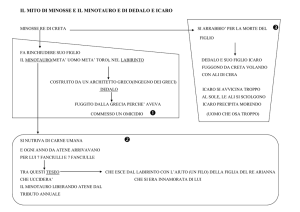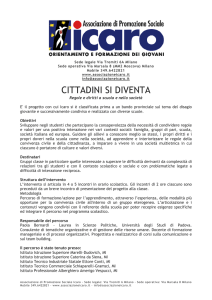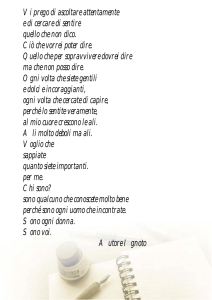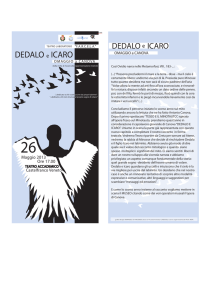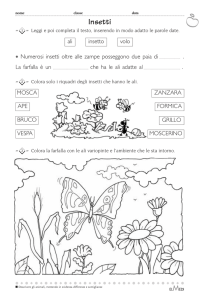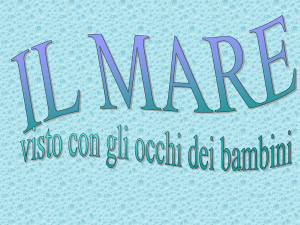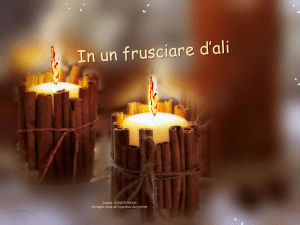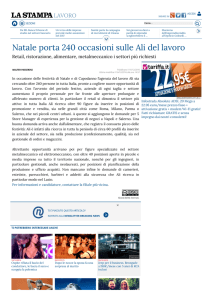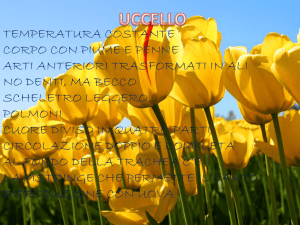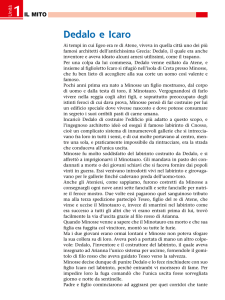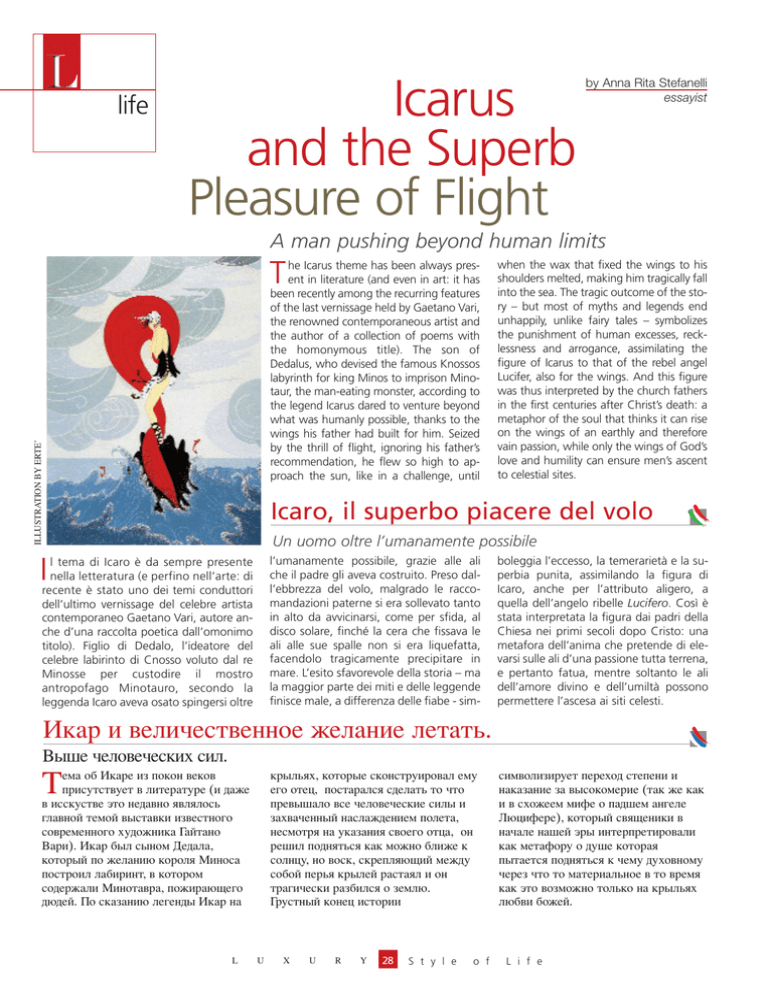
life
Icarus
and the Superb
Pleasure of Flight
by Anna Rita Stefanelli
essayist
A man pushing beyond human limits
T
ILLUSTRATION BY ERTE’
he Icarus theme has been always present in literature (and even in art: it has
been recently among the recurring features
of the last vernissage held by Gaetano Vari,
the renowned contemporaneous artist and
the author of a collection of poems with
the homonymous title). The son of
Dedalus, who devised the famous Knossos
labyrinth for king Minos to imprison Minotaur, the man-eating monster, according to
the legend Icarus dared to venture beyond
what was humanly possible, thanks to the
wings his father had built for him. Seized
by the thrill of flight, ignoring his father’s
recommendation, he flew so high to approach the sun, like in a challenge, until
when the wax that fixed the wings to his
shoulders melted, making him tragically fall
into the sea. The tragic outcome of the story – but most of myths and legends end
unhappily, unlike fairy tales – symbolizes
the punishment of human excesses, recklessness and arrogance, assimilating the
figure of Icarus to that of the rebel angel
Lucifer, also for the wings. And this figure
was thus interpreted by the church fathers
in the first centuries after Christ’s death: a
metaphor of the soul that thinks it can rise
on the wings of an earthly and therefore
vain passion, while only the wings of God’s
love and humility can ensure men’s ascent
to celestial sites.
Icaro, il superbo piacere del volo
Un uomo oltre l’umanamente possibile
l’umanamente possibile, grazie alle ali
che il padre gli aveva costruito. Preso dall’ebbrezza del volo, malgrado le raccomandazioni paterne si era sollevato tanto
in alto da avvicinarsi, come per sfida, al
disco solare, finché la cera che fissava le
ali alle sue spalle non si era liquefatta,
facendolo tragicamente precipitare in
mare. L’esito sfavorevole della storia – ma
la maggior parte dei miti e delle leggende
finisce male, a differenza delle fiabe - sim-
I
l tema di Icaro è da sempre presente
nella letteratura (e perfino nell’arte: di
recente è stato uno dei temi conduttori
dell’ultimo vernissage del celebre artista
contemporaneo Gaetano Vari, autore anche d’una raccolta poetica dall’omonimo
titolo). Figlio di Dedalo, l’ideatore del
celebre labirinto di Cnosso voluto dal re
Minosse per custodire il mostro
antropofago Minotauro, secondo la
leggenda Icaro aveva osato spingersi oltre
boleggia l’eccesso, la temerarietà e la superbia punita, assimilando la figura di
Icaro, anche per l’attributo aligero, a
quella dell’angelo ribelle Lucifero. Così è
stata interpretata la figura dai padri della
Chiesa nei primi secoli dopo Cristo: una
metafora dell’anima che pretende di elevarsi sulle ali d’una passione tutta terrena,
e pertanto fatua, mentre soltanto le ali
dell’amore divino e dell’umiltà possono
permettere l’ascesa ai siti celesti.
кар и величественное желание летать.
ыше человеческих сил.
ема об каре из покон веков
присутствует в литературе (и даже
в исскустве это недавно являлось
главной темой выставки известного
современного художника айтано
ари). кар был сыном !едала,
который по желанию короля #иноса
построил лабиринт, в котором
содержали #инотавра, пожирающего
дюдей. %о сказанию легенды кар на
L
крыльях, которые сконструировал ему
его отец, постарался сделать то что
превышало все человеческие силы и
захваченный наслаждением полета,
несмотря на указания своего отца, он
решил подняться как можно ближе к
солнцу, но воск, скрепляющий между
собой перья крылей растаял и он
трагически разбился о землю.
рустный конец истории
U
X
U
R
Y
28
S t y l e
o f
символизирует переход степени и
наказание за высокомерие (так же как
и в схожеем мифе о падшем ангеле
+юцифере), который священики в
начале нашей эры интерпретировали
как метафору о душе которая
пытается подняться к чему духовному
через что то материальное в то время
как это возможно только на крыльях
любви божей.
L i f e
www.shri.it
Gold is better...
better
SHOWROOM:
7FSPOB"JSQPSUt.JMBOPt7FOF[JBt'JSFO[Ft3PNBt-POEPOt.PTDPXt%VCBJt)POH,POHt5PLZPt.JBNJ

